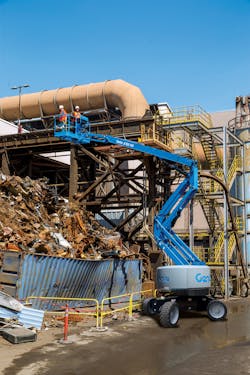Construction Jobs in May Lag Pre-Pandemic Peak in 42 States, Says AGC
Seasonally adjusted construction employment in May trailed the February 2020 level in 42 states and the District of Columbia and exceeded it in eight states, according to Associated General Contractor’s analysis of Bureau of Labor Statistics (BLS) data posted last week. (February 2020 was the month in which employment peaked nationally before plunging during widespread shutdowns in March and April 2020.)
Texas lost the most construction jobs since February 2020 (-49,100 jobs or -6.3%), followed by New York (-45,200, -11%), California (-30,400, -3.4%), Louisiana (-20,700, 15%), and New Jersey (-16,600, -10%). Wyoming recorded the largest percentage loss (-15%, -3,500 jobs), followed by Louisiana, New York, and New Jersey. Utah added the most jobs (5,000, 4.4%), followed by Idaho (3,400, 6.2%), South Dakota (1,200, 5%), South Carolina (1,100 1.0%), and Washington (1,000, 0.5%). Idaho added the highest percentage, followed by South Dakota, Utah, Rhode Island (2.5%, 500), and South Carolina.
For the month, construction employment declined in 40 states and D.C, increased in 8 states, and held steady in Utah and Colorado. Florida added the most construction jobs from April to May (3,700, 0.7%), followed by Michigan (1,600, 0.9%), Minnesota (1,200, 1.0%), Oklahoma (1,000, 1.3%), and Oregon (900, 0.8%). Oklahoma had the largest monthly percentage increase, followed by Minnesota, Michigan, Oregon, and Florida. New York lost the most construction jobs for the month (-5,900, -1.6%), followed by Illinois (-5,600, -2.5%), Georgia (-2,700, -1.3%), and Washington (-2,600, -1.2%). Vermont had the largest percentage loss (-4.0%, -600 jobs), followed by Maine (-3.6%, -1,100 jobs) and Delaware (-3.0%, -700). (BLS reports combined totals for mining, logging, and construction in D.C., Delaware and Hawaii. Because there are few, if any, mining and logging jobs in these locations, AGC treats the levels and changes as solely construction employment.)
Materials cost increases and supply-chain delays continue to plague the industry. Today, AGC posted a third edition of its Construction Inflation Alert, a document to help owners, officials, and others understand the problems and ways to mitigate it.
The Architecture Billings Index (ABI) reached its highest level since 2006 in May, with a reading of 58.5, up from 57.9 in April, the American Institute of Architects reported on Wednesday. AIA said, “The ABI serves as a leading economic indicator that leads nonresidential construction activity by approximately 9-12 months.” The ABI is derived from the share of responding architecture firms that report a gain in billings over the previous month less the share reporting a decline in billings, presented on a 0-to-100 scale. Any score above 50 means that firms with increased billings outnumbered firms with decreased billings. Scores by practice specialty (based on three-month moving averages) topped 50 for the fourth time in a row: commercial/industrial, 60.6 (the highest since the ABI began in 1995 and up from 58.3 in April); multifamily residential, 59.5 (a 16-year high, up from 58.5); mixed practice, 57.9 (highest since 2007 and up from 56.5); and institutional, 57.1 (highest since 2007 and up from 56.8). A similar index for new design contracts, begun in 2010, reached its second consecutive record high with a score of 63.2.
“The latest obstacle hitting global shipping is likely to jolt trade flows for several more weeks,” the Wall Street Journal reported on Tuesday. “Shipping executives say around 50 container ships remain backed up around the Yantian port in Southern China and that some 350,000 loaded containers are stacked up on docks as the major gateway for China goods heading to Western nations struggles to recover from a Covid-19 outbreak that disrupted operations there….Ship backups are still hobbling transport through California’s ports of Los Angeles and Long Beach, which make up the biggest gateway in the U.S. for Asia imports. A bottleneck offshore has eased since the first quarter…But shipping companies and their customers report growing delays in getting goods moved inland because of congestion and freight equipment shortages.”
Steel prices and lead times are climbing again. “Fastmarkets’ monthly assessment for steel wire rod (low carbon) industrial quality, FOB mill US was $53-55 per cwt ($1,060-1,100 per ton) on Tuesday, June 15, up by 8% from $49-51 per cwt on May 18 and its highest since the assessment stood at $54 per cwt in early November 2008.…Prices have been pushed higher for industrial quality wire rod over the past month, driven in part by higher scrap prices and by a tightening of supply due to outages at the Cascade Steel Rolling Mill in McMinnville, Ore., and the Evraz Rocky Mountain Steel mill in Pueblo, Colo., as well as an upcoming planned outage at Optimus Steel’s operations in Beaumont, Texas, according to market participants. The upward pressure on prices is being reflected in sharply higher prices for imports, when they are available, because there has been so little domestic production available outside allocation agreements with regular users, according to a trader…. For regular customers on allocation, lead times were reported at four to six weeks; for others, lead times stretched from 90-120 days.”
